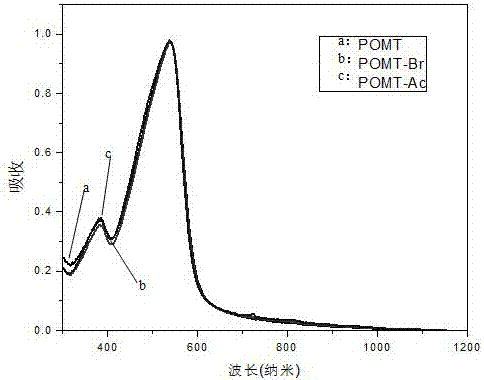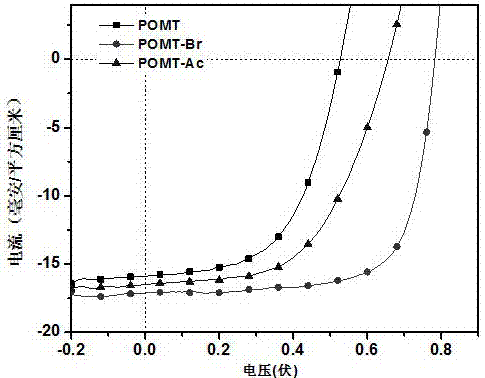Benzo diimide ring-containing n type water/alcohol soluble conjugated polymer and application thereof to organic/polymer photoelectric devices
A technology of phthalimide rings and conjugated polymers, applied in coatings and other directions, can solve problems such as unfavorable industrialization of polymer solar cells, improve processing technology and device performance, improve energy level structure, and improve performance Effect
- Summary
- Abstract
- Description
- Claims
- Application Information
AI Technical Summary
Problems solved by technology
Method used
Image
Examples
Embodiment 1
[0038] Preparation of 2,5-dibromo-N,N'-diisooctyl-1,3,4,6-phthalimide (abbreviated as BDIEH2Br)
[0039] The steps and reaction conditions of the chemical reaction are as follows:
[0040]
[0041] (1) Intermediate 1 was prepared according to the method disclosed in literature [Polymer Chemistry, 2015, 53(13), 1617-1622].
[0042] (2) Preparation of 2,5-dibromo-N,N'-diisooctyl-1,3,4,6-phthalimide
[0043]Take 1.128g of the monomer 2,5-dibromo-phthalic anhydride monomer in a 250ml two-necked bottle with a stirring bar, add about 100ml of acetic acid after 20 minutes of nitrogen gas, stir and nitrogen gas for 10 minutes, so that the raw materials are fully dissolve. Under nitrogen protection, 2.074 g of 2-ethylhexylamine was added. When adding, it should be added slowly so that 2-ethylhexylamine can be fully dispersed in the reaction system. After another 15 minutes of nitrogen gas flow, the nitrogen gas flow was stopped, the two-port reaction flask was closed, and heated...
Embodiment 2
[0056] The polymer synthesized by the case implemented above is used in an organic solar cell, and this example is used to illustrate that the n-type water-alcohol-soluble conjugated polymer containing a phthalimide ring proposed by the present invention is used as an electron transport layer in an organic solar cell. Applications in organic optoelectronic devices.
[0057] The following example illustrates the manufacturing process of the material proposed by the present invention in an organic solar cell device, but the practical application is not limited to this example.
[0058] Wash the indium tin oxide (ITO) conductive glass with acetone, micron-scale semiconductor special detergent, deionized water, and isopropanol as cleaning solvents in an ultrasonic cleaner. After washing, blow dry the surface with nitrogen and dry it with an infrared lamp. , and then placed in a constant temperature oven for later use. Before use, the ITO glass was etched by plasma in a plasma etc...
Embodiment 3
[0069] Electron transport layers with different thicknesses were prepared from POMT-Br to illustrate the influence of interface thickness on device performance.
[0070] The specific implementation process is similar to Case 2, but when the electron transport layer is spin-coated, the rotational speed of the spin-coating is controlled separately, so that the thickness is limited to 5nm, 15nm, and 60nm respectively. The specific device efficiencies at different thicknesses are shown in Table 2.
PUM
| Property | Measurement | Unit |
|---|---|---|
| thickness | aaaaa | aaaaa |
Abstract
Description
Claims
Application Information
 Login to View More
Login to View More - R&D
- Intellectual Property
- Life Sciences
- Materials
- Tech Scout
- Unparalleled Data Quality
- Higher Quality Content
- 60% Fewer Hallucinations
Browse by: Latest US Patents, China's latest patents, Technical Efficacy Thesaurus, Application Domain, Technology Topic, Popular Technical Reports.
© 2025 PatSnap. All rights reserved.Legal|Privacy policy|Modern Slavery Act Transparency Statement|Sitemap|About US| Contact US: help@patsnap.com



